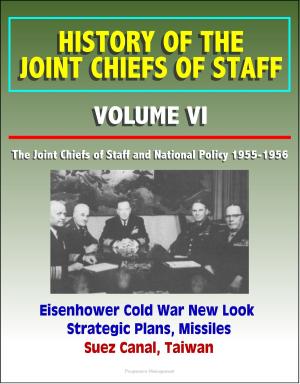Planning for Action: Campaign Concepts and Tools - Wargaming, Military Decision Making Process (MDMP), Joint Operation Planning Process (JOPP), Military End State, Measurements of Performance (MOP)
Nonfiction, History, Military, United States| Author: | Progressive Management | ISBN: | 9781301391837 |
| Publisher: | Progressive Management | Publication: | March 13, 2013 |
| Imprint: | Smashwords Edition | Language: | English |
| Author: | Progressive Management |
| ISBN: | 9781301391837 |
| Publisher: | Progressive Management |
| Publication: | March 13, 2013 |
| Imprint: | Smashwords Edition |
| Language: | English |
The purpose for this book is straightforward: to provide an overview of planning principles and the tools used by planners to design campaign plans. Since 9/11, the US military has been involved in numerous actions, most notably in Iraq and Afghanistan. The approach to campaign planning has changed and evolved over this time, spawning a number of new concepts and approaches to planning; this book is intended to provide some assistance in understanding and applying those concepts and approaches. A campaign is defined as "a series of related major operations aimed at achieving strategic and operational objectives within a given time and space."1 That's a fairly broad definition for a campaign - but campaigns are normally joint operations (which means it is conducted by more than one service of the US military) and relates directly to strategic level or national objectives. Put another way, campaigns are fought because the US President has decided that our national level objectives necessitate the commitment of US military forces.
Today, campaigns also require the integration of both military and non-military national level instruments of power to achieve "unity of action." Our campaigns today require both civilian and military resources to fully accomplish national level objectives. Those objectives are aimed towards changing the conditions "at a given time and space" to conditions that are desirable for the United States. We conducted (and are still conducting) campaigns in Iraq and Afghanistan (and elsewhere) because the US President decided that the conditions in those areas required the commitment of US forces to change those conditions. This required the commitment of not only US forces, but also the commitment of civilian resources and lots of money. Tying this all together in a coherent fashion in order to ultimately meet US national objectives requires detailed campaign planning.
Some of the subjects covered include General Ridgway in Korea, John Warden's Five Rings, Operation Enduring Freedom, and Dr. Joe Strange.
Introduction * PART I: Planning for Action Concepts * Chapter 1: Problem Solving * Chapter 2: Ends, Ways, and Means * Chapter 3: Understand * Chapter 4: Visualize * Chapter 5: Describe * Chapter 6: Exercising Collaborative Leadership * Chapter 7: Framing and Reframing * Chapter 8: Developing the Narrative . * PART II: Planning for Action Tools * Chapter 9: Centers of Gravity * Chapter 10: Developing Distinct Courses of Action * Chapter 11: Lines of Effort * Chapter 12: Critical Factor Analysis (CC-CR-CV) * Chapter 13: Target Value Analysis * Chapter 14: Wargaming * Chapter 15: Assessment (MOE and MOP) * Chapter 16: Parting Thoughts * Appendix A: General Ridgway in Korea * Appendix B: Examples
The purpose for this book is straightforward: to provide an overview of planning principles and the tools used by planners to design campaign plans. Since 9/11, the US military has been involved in numerous actions, most notably in Iraq and Afghanistan. The approach to campaign planning has changed and evolved over this time, spawning a number of new concepts and approaches to planning; this book is intended to provide some assistance in understanding and applying those concepts and approaches. A campaign is defined as "a series of related major operations aimed at achieving strategic and operational objectives within a given time and space."1 That's a fairly broad definition for a campaign - but campaigns are normally joint operations (which means it is conducted by more than one service of the US military) and relates directly to strategic level or national objectives. Put another way, campaigns are fought because the US President has decided that our national level objectives necessitate the commitment of US military forces.
Today, campaigns also require the integration of both military and non-military national level instruments of power to achieve "unity of action." Our campaigns today require both civilian and military resources to fully accomplish national level objectives. Those objectives are aimed towards changing the conditions "at a given time and space" to conditions that are desirable for the United States. We conducted (and are still conducting) campaigns in Iraq and Afghanistan (and elsewhere) because the US President decided that the conditions in those areas required the commitment of US forces to change those conditions. This required the commitment of not only US forces, but also the commitment of civilian resources and lots of money. Tying this all together in a coherent fashion in order to ultimately meet US national objectives requires detailed campaign planning.
Some of the subjects covered include General Ridgway in Korea, John Warden's Five Rings, Operation Enduring Freedom, and Dr. Joe Strange.
Introduction * PART I: Planning for Action Concepts * Chapter 1: Problem Solving * Chapter 2: Ends, Ways, and Means * Chapter 3: Understand * Chapter 4: Visualize * Chapter 5: Describe * Chapter 6: Exercising Collaborative Leadership * Chapter 7: Framing and Reframing * Chapter 8: Developing the Narrative . * PART II: Planning for Action Tools * Chapter 9: Centers of Gravity * Chapter 10: Developing Distinct Courses of Action * Chapter 11: Lines of Effort * Chapter 12: Critical Factor Analysis (CC-CR-CV) * Chapter 13: Target Value Analysis * Chapter 14: Wargaming * Chapter 15: Assessment (MOE and MOP) * Chapter 16: Parting Thoughts * Appendix A: General Ridgway in Korea * Appendix B: Examples















